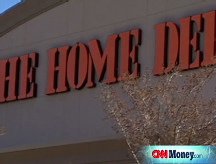Home building at 17-year low
Housing starts and permits both fall sharply in July to levels not seen since 1991 recession.
NEW YORK (CNNMoney.com) -- Home building fell sharply in July to a 17-year low, according to government readings released Tuesday that offered fresh signs that the battered real estate market has yet to hit bottom.
Housing starts plunged 11% to an annual rate of 965,000 from a revised 1.084 million pace in June, according to the Census Bureau report. Economists surveyed by Briefing.com had forecast starts would fall to a rate of 960,000.
Permits - often seen as a sign of builders' confidence in the housing market - tumbled 17% to an annual rate of 937,000 from a revised 1.138 million in June. Economists had forecast that permits would come in at 959,000.
The sharp percentage drop from June was due partly to a jump in multi-family home starts and permits during that month. Single-family home starts and permits slipped only slightly from the June level. But the single-family starts were also at a 17-year low in July, while single-family permits fell to a level not seen since the 1982 recession, reaching a rate of only 584,000 homes in July.
The sharp fall in building activity suggests that home building will continue to be a drag on the economy in the second half of 2008. Earlier this year, many economists hoped that building activity would bottom out this summer and start to show signs of improvement.
In the second quarter, the drop in home building took 0.6 percentage points off gross domestic product, the broad measure of the nation's economic activity. It marked the 10th straight quarter that home building has been a drag on GDP.
But the continued drop in building could be just what the battered real estate market needs. One of the biggest problem for sellers is a glut of unsold homes on the market. Since demand for homes remains weak, the glut will only ease if fewer new homes are built.
In June, builders faced a median wait of 8.4 months to sell a completed home, the longest delay in selling time in 25 years, according to a separate Census Bureau report issued recently.
David Seiders, chief economist for the National Association of Home Builders, says he's hopeful the historically low levels of single-family permits is a sign that the glut of homes on the market could finally start to decline.
Seiders said he's hopeful that the market for new homes will hit bottom in late 2008 or early 2009. But he added that his forecast could prove optimistic given other problems, such as rising job losses and the credit crunch. And the continuing rise in foreclosures adds to the glut of homes available for sale, particularly in markets such as California and Florida.
"We're dealing with a weakening economy in the second half of this year, and early '09 doesn't look that great either," Seiders said. "We don't have any numbers that really show stabilization in the housing market yet."
The government report on housing starts and permits comes the day after a survey of builder confidence by the National Association of Home Builders remained at a record low in August. Only 5% of builders said the current market is good, 8% said they expected a favorable market in the next six months and fewer than 2% said they were seeing strong traffic from potential buyers.
The downturn in housing and building has hammered the results of most of the nation's major builders. Late last month Centex (CTX, Fortune 500), which is the No. 2 builder by revenue, reported a larger-than-expected loss and warned it was seeing no improvement in the home building market.
Most builders have reported larger than expected losses, although Pulte Home (PHM, Fortune 500), the largest builder by revenue, did slightly better than forecasts. Only one major builder, NVR (NVR, Fortune 500), has reported a profit through the current downturn, although its earnings have plunged.
As a group, the revenue of the nation's eight largest home builders has plunged 37% over the last year. Analysts surveyed by Thomson Reuters are forecasting another 36% drop in revenue over the course of the next 12 months. ![]()



